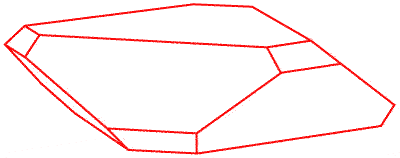Ilmenite is an iron titanium oxide. It is the principal ore of titanium. It is black (or dark gray) and has a metallic luster. It is usually weakly magnetic. The mineral itself is actually not magnetic, but it is often intergrown with magnetite, which very strongly responds to the magnetic force. You can use a hand-held magnet to test sand grains. If they are only lazily turning themselves but not jumping vigorously towards the magnet, then they are most likely ilmenite grains, not magnetite.

Ilmenite in anorthositic host rock. Blåfjell mine, Rogaland, Norway. The sample is from an abandoned mine, but not far from Blåfjell is a working Tellenes mine (picture below). Width of sample 13 cm.
Another aspect that separates it from magnetite is the crystal structure. Magnetite is an isometric mineral, it forms double pyramids (octahedrons) just like diamond. These octahedrons are often worn off in sand, but in this case magnetite is rounded and still roughly isometric. Ilm. is at least theoretically different, its grains tend to be tabular. These minerals are both opaque minerals.
The crystal structure of is identical to hematite. It is compositionally pretty close to hematite as well. The only difference between them is that one Fe atom (in hematite) is replaced by titanium atom (in ilmenite). The chemical formula is FeTiO3. This is ideal formula which often is pretty close to the reality, but some of the iron may be replaced with magnesium and manganese.

Beach sand from India containing lots of ilmenite. Brown grain in the lower left is leucoxene. Light blue elongated grain is kyanite. Transparent crystals are quartz grains. The width of the view is 5 mm.

Ilmenite crystal should ideally look like this.
Grains are often altered to leucoxene. Leucoxene is a mixture of several oxide minerals, it is not a mineral itself. It looks like a very fine-grained light-colored or brownish coating on ilmenite grains.
Ilmenite is found in igneous and metamorphic rocks although it very rarely forms a major component of a rock. If that happens (in iron- and titanium-rich magmatic cumulates) then it is usually mined for its titanium content. Titanium extracted from ilm. in the form of titanium dioxide is used as a white pigment in paints and sunscreens among other things. Millions of tonnes of ilmenite are mined every year, but the majority of it comes from sand, not from the hard rocks. It is resistant to weathering and therefore common in sand. It is usually accompanied by magnetite and possibly by a small amount of rutile and zircon as well (they are even more resistant to weathering).

Tellenes mine in Norway. It is fun to think that white paint and sunscreen come from this black hole. Image: Mikenorton/Wikipedia.

Ilmenite and leucoxene grains. Some grains demonstrate half-completed leucoxenisation process (few examples are annotated). The width of the view is 3.8 mm.

Beach sand containing ilmenite (black), leucoxene, quartz, almandine, and zircon. Calvert Cliffs State Park, Soloman Islands, Maryland.